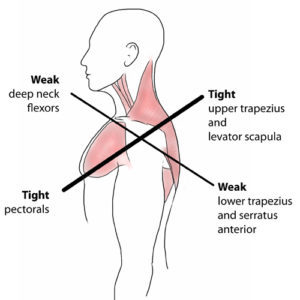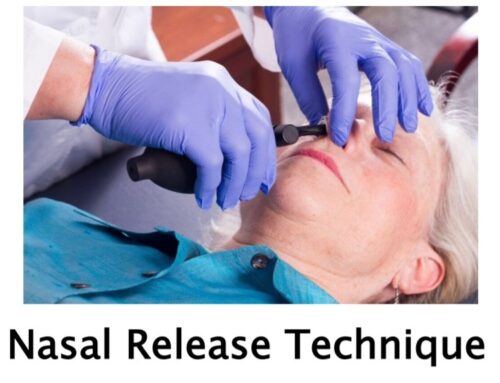Upper Cross Syndrome
Your posture plays an important role in your overall health. Poor posture leads to chronic strain and discomfort. “Upper cross syndrome” describes poor posture that results from excessive tightness in your shoulders and chest with weakness in your neck and mid-back. This combination forces your shoulders to roll inward and your head to project forward.
To help understand how upper cross syndrome causes trouble, think of your spine as a telephone pole and your head as a bowling ball that sits on top. When the bowling ball is positioned directly over the top of the upright post, very little effort is required to keep it in place. If you tip the post forward and the ball begins to roll over the edge of the post, significantly more effort would be required from the muscles trying to hold it there. This effort results in a chronic strain of the muscles of your neck and upper back. The chronic strain is uncomfortable and may also lead to neck pain, upper back pain, headaches, TMJ pain, and ultimately- arthritis.

This postural problem is exceptionally common in computer workstation users. Correction of this problem is accomplished by stretching the tight muscles, strengthening weak muscles, and modifying your workstation. Here is a brief description of the tools we can use to help correct upper crossed syndrome:
1. Joint Manipulation – Your chiropractor has found joints in your body that are not moving freely. This can cause tightness and discomfort and can accelerate unwanted degeneration i.e. arthritis. Your chiropractor will apply a gentle force with their hands, or with handheld instruments, in order to restore motion to any “restricted” joints. Sometimes a specialized table will be used to assist with these safe and effective “adjustments”. Joint manipulation improves flexibility, relieves pain and helps maintain healthy joints.
2. Therapy Modalities – We may apply electrotherapy modalities that produce light electrical pulses transmitted through electrodes placed over your specific sites of concern. These comfortable modalities work to decrease your pain, limit inflammation and ease muscle spasms. Hot or cold packs are often used in conjunction, to enhance the effect of these modalities. Another available option is therapeutic low-level laser therapy. Low-level laser therapy pushes light energy into the cells, speeding up their cellular function and improving cellular communication, allowing the injured tissues to function at a higher level for a short time. This will help to improve circulation, decrease pain and muscle tension and disperse unwanted waste products.
3. Myofascial Release – Overworked muscles often become tight and develop knots or “trigger points”. Chronic tightness produces inflammation and swelling that ultimately leads to the formation of “adhesions” between tissues. Your chiropractor will apply pressure with their hands, or with specialized tools, in order to release muscle tightness and soft-tissue adhesions. This will help to improve your circulation, relieve pain and restore flexibility.
4. Therapeutic Exercises – Muscle tightness ore weakness causes discomfort and alters normal joint function, leading to additional problems. We target tight or weak muscles with specific therapeutic stretching and strengthening to help increase tissue flexibility, build strength, and ease the pain. Healthy, strong, and flexible muscles may help prevent re-injury.
We use a combination of all four treatment options to get you out of pain as quickly as we can while providing lasting relief for long-term results.
For more information about upper cross, syndrome check out this link.



